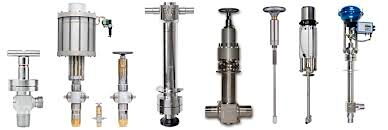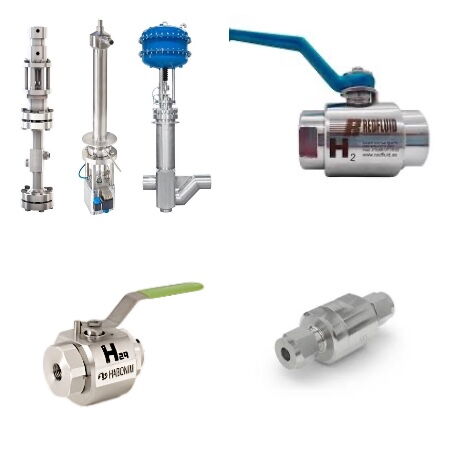A Complete Guide to Hydrogen Valves
On this page
Hydrogen valves are key components in the production, storage, transportation and application of hydrogen, ensuring the safe, efficient and stable operation of the system. Hydrogen systems are extremely dangerous. The flammability limit and detonation limit of hydrogen at normal temperature and pressure, the impact of high-speed detonation waves on the surrounding environment with high-temperature gas propagation, the low-temperature environment of liquid hydrogen and hydrogen propulsion systems causing material toughness to decrease and increase crack sensitivity, leakage due to material shrinkage during hydrogen liquefaction, hydrogen corrosion and bubbling from long-term exposure to high-pressure hydrogen environments, abnormal pressure increases in closed spaces due to temperature, frostbite from direct contact with low-temperature hydrogen, high-temperature burns from hydrogen flames, and large amounts of ultraviolet radiation damage from hydrogen combustion.


The main valves used in hydrogen systems include check valves, throttle valves, flow control valves, ball valves, globe valves, and pressure safety valves. To prevent hydrogen particles from accumulating, precipitating, and clogging pipes and valves, filters should also be installed in the hydrogen system.


Hydrogen can easily leak through the valve body/bonnet, non-metallic material sealing gaskets, valve stem packing, and other locations. After hydrogen leaks, it will spread rapidly, causing the flammable and explosive areas to expand continuously, and the diffusion process is invisible to the naked eye. After liquid hydrogen and hydrogen propellant system leaks, the liquid hydrogen and hydrogen propellant quickly spread to form visible explosive fog and may cause the system to form negative pressure. The surrounding air enters the system and condenses and freezes, blocking the system's pipes and valves. Hydrogen leakage can cause hydrogen loss or damage to the vacuum insulation layer. Hydrogen valve internal leakage is caused by the valve sealing surface. After hydrogen leaks, it is easy to cause negative pressure in the upstream pipeline and accidents due to hydrogen filling in the downstream pipeline or environment. Hydrogen valve external leakage can cause physiological harm to the human body.
The temperature drops sharply during the hydrogen liquefaction process, causing material shrinkage. Due to the different deformation and shrinkage of each component, the deformation is not coordinated, resulting in increased stress in the structure and leakage of the valve sealing surface. The low-temperature environment of liquid hydrogen and hydrogen propellant systems causes the toughness of materials to decrease, increasing the crack sensitivity of materials and causing safety accidents.
After the hydrogen valve has been in service for a certain period in a high-temperature and high-pressure hydrogen environment, hydrogen can react with carbon atoms in steel to generate methane, causing decarburization and microcrack formation in the steel, leading to irreversible degradation. The higher the temperature and the greater the hydrogen partial pressure, the more serious the hydrogen corrosion of steel. After the metal absorbs internal or external hydrogen, when the partial hydrogen concentration reaches saturation, it will cause the material's toughness and plasticity to decrease, induce cracking or delay fracture. The higher the temperature, the greater the hydrogen partial pressure, and the greater the strain rate, the greater the hydrogen embrittlement of the metal.
(1) The hydrogen valve type should be appropriate for the hydrogen system.
(2) When the pipeline design pressure is ≥2.5 MPa, the flange sealing surface connecting the valve and the pipeline should use a concave and convex surface, a birch groove surface, a ring connection surface, or a butt weld.
(3) Threaded connections should not be used for valves, pipes, and equipment in liquid hydrogen and hydrogen propellant systems.
(4) A self-starting device should be used for hydrogen throttle valves. When the flow rate reaches the preset maximum value, the throttle valve should close automatically. Ball valves and globe valves should be used as cut-off valves.
(5) Low-temperature ball valves should prevent damage caused by abnormal pressure increases of liquid hydrogen remaining in the valve cavity when the valve is closed.
(6) Globe valves should be installed in the liquid hydrogen return pipeline as close to the container as possible. There should be no other accessories between the globe valve and the container.
(7) Valve materials and seals should be selected according to working pressure, working temperature, and compatibility with hydrogen.
(8) Non-metallic seals in valves should avoid high permeability that may cause seal failure or hydrogen leakage.
(9) Safety valves should be fully enclosed and installed vertically on the discharge pipeline for easy observation and maintenance. Safety valves should be installed close to the protected equipment.
(10) Filters should be easy to disassemble and clean. Filters should be installed in the filling pipeline or supply pipeline.

(2) When the pipeline design pressure is ≥2.5 MPa, the flange sealing surface connecting the valve and the pipeline should use a concave and convex surface, a birch groove surface, a ring connection surface, or a butt weld.
(3) Threaded connections should not be used for valves, pipes, and equipment in liquid hydrogen and hydrogen propellant systems.
(4) A self-starting device should be used for hydrogen throttle valves. When the flow rate reaches the preset maximum value, the throttle valve should close automatically. Ball valves and globe valves should be used as cut-off valves.
(5) Low-temperature ball valves should prevent damage caused by abnormal pressure increases of liquid hydrogen remaining in the valve cavity when the valve is closed.
(6) Globe valves should be installed in the liquid hydrogen return pipeline as close to the container as possible. There should be no other accessories between the globe valve and the container.
(7) Valve materials and seals should be selected according to working pressure, working temperature, and compatibility with hydrogen.
(8) Non-metallic seals in valves should avoid high permeability that may cause seal failure or hydrogen leakage.
(9) Safety valves should be fully enclosed and installed vertically on the discharge pipeline for easy observation and maintenance. Safety valves should be installed close to the protected equipment.
(10) Filters should be easy to disassemble and clean. Filters should be installed in the filling pipeline or supply pipeline.

Currently, the following standards are primarily used for the design, manufacture, inspection, and testing of hydrogen valves used in hydrogen systems:
· ISO 19880-3:2018 "Gaseous hydrogen -- Fuelling stations -- Part 3: Valves"
· ASME B31.12 "Hydrogen Piping and Pipelines"
· ISO 14687 "Hydrogen fuel quality -- Product specification"
· EN 13643 "Cryogenic vessels -- Safety devices for protection against excessive pressure"
· API 600 "Steel Gate Valves -- Flanged and Butt-welding Ends, Bolted Bonnets"
· GB/T 34542 "General Technical Specifications for Equipment Used in Hydrogen Fueling Stations"
· ISO 19880-3:2018 "Gaseous hydrogen -- Fuelling stations -- Part 3: Valves"
· ASME B31.12 "Hydrogen Piping and Pipelines"
· ISO 14687 "Hydrogen fuel quality -- Product specification"
· EN 13643 "Cryogenic vessels -- Safety devices for protection against excessive pressure"
· API 600 "Steel Gate Valves -- Flanged and Butt-welding Ends, Bolted Bonnets"
· GB/T 34542 "General Technical Specifications for Equipment Used in Hydrogen Fueling Stations"
(1) Commonly used metal for hydrogen systems are S31603 and S31608. These materials are solution-treated, and aluminum alloy 6061 is aging-heat-treated (though less commonly used).
(2) When selecting austenitic stainless steel, both hydrogen-induced cracking and resistance to gaseous stress corrosion cracking should be considered. For aluminum alloy materials, resistance to continuous load cracking should be evaluated.
(3) Metal in contact with hydrogen should exhibit acceptable compatibility with hydrogen, paying special attention to hydrogen embrittlement and hydrogen-accelerated corrosion fatigue.
(4) Materials in contact with liquid hydrogen and hydrogen propellants should have sufficient toughness at low temperatures.
(5) In the low-temperature environment of liquid hydrogen and hydrogen propellants, the valve body, valve bonnet, valve stem, and valve core should undergo low-temperature deep cryogenic treatment. This treatment reduces stress increases in the structure and valve seal leakage caused by inharmonious shrinkage and deformation of the materials at low temperatures.
(6) Non-metallic materials in contact with hydrogen should demonstrate acceptable compatibility with it. Non-metallic materials diffuse more easily in a hydrogen environment than metals, so the suitability of these materials must be verified.
(7) Non-metallic materials should maintain their mechanical stability in terms of strength under all specified conditions of use and lifespan, including fatigue performance, endurance limit, and strain strength.
(8) The requirements for valve materials used in hydrogen systems can be found in Article 5 of JB/T 11484-2011.
(9) The effects of hydrogen on the mechanical properties of materials are detailed in ISO/TR 15916.
(2) When selecting austenitic stainless steel, both hydrogen-induced cracking and resistance to gaseous stress corrosion cracking should be considered. For aluminum alloy materials, resistance to continuous load cracking should be evaluated.
(3) Metal in contact with hydrogen should exhibit acceptable compatibility with hydrogen, paying special attention to hydrogen embrittlement and hydrogen-accelerated corrosion fatigue.
(4) Materials in contact with liquid hydrogen and hydrogen propellants should have sufficient toughness at low temperatures.
(5) In the low-temperature environment of liquid hydrogen and hydrogen propellants, the valve body, valve bonnet, valve stem, and valve core should undergo low-temperature deep cryogenic treatment. This treatment reduces stress increases in the structure and valve seal leakage caused by inharmonious shrinkage and deformation of the materials at low temperatures.
(6) Non-metallic materials in contact with hydrogen should demonstrate acceptable compatibility with it. Non-metallic materials diffuse more easily in a hydrogen environment than metals, so the suitability of these materials must be verified.
(7) Non-metallic materials should maintain their mechanical stability in terms of strength under all specified conditions of use and lifespan, including fatigue performance, endurance limit, and strain strength.
(8) The requirements for valve materials used in hydrogen systems can be found in Article 5 of JB/T 11484-2011.
(9) The effects of hydrogen on the mechanical properties of materials are detailed in ISO/TR 15916.



